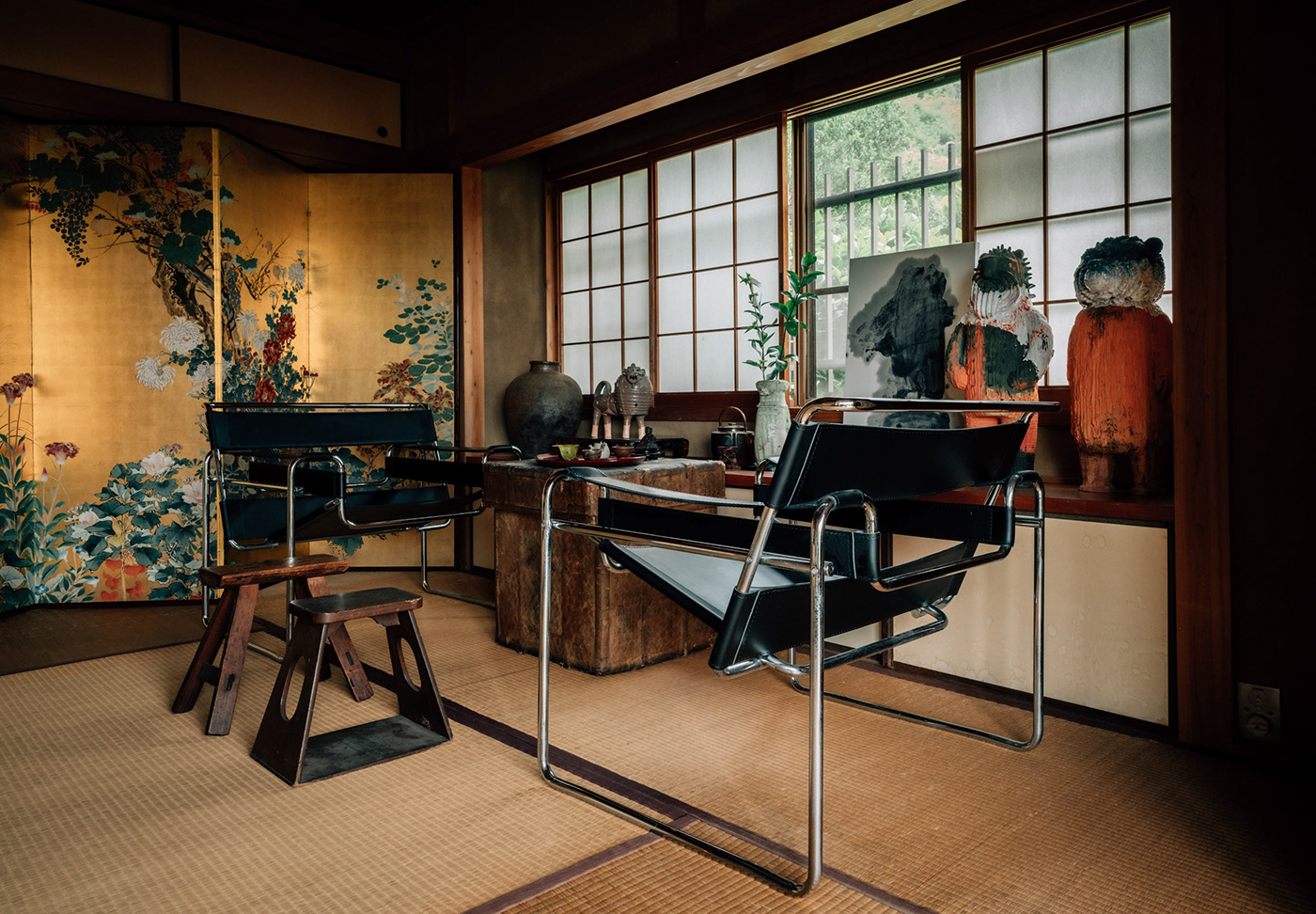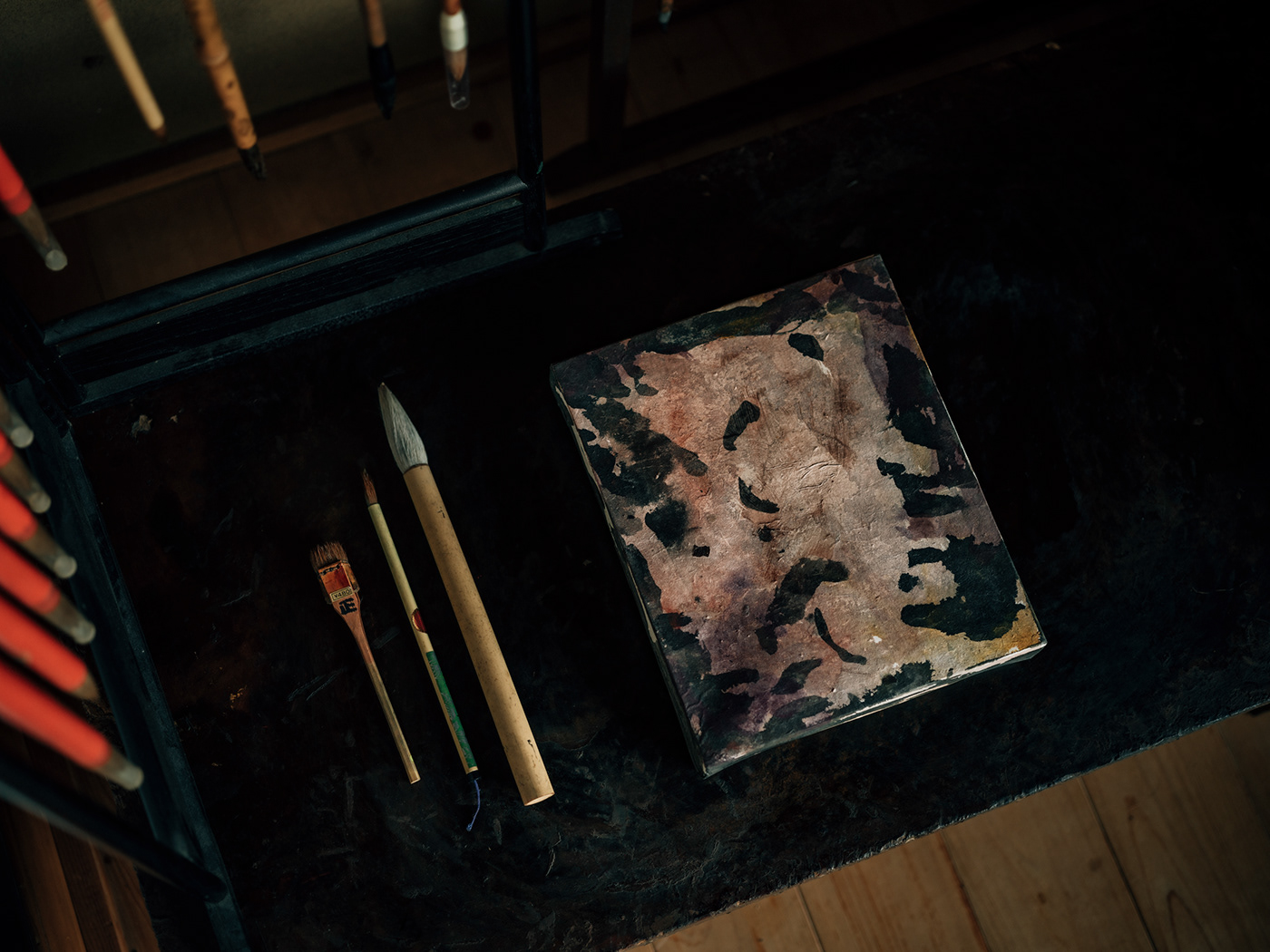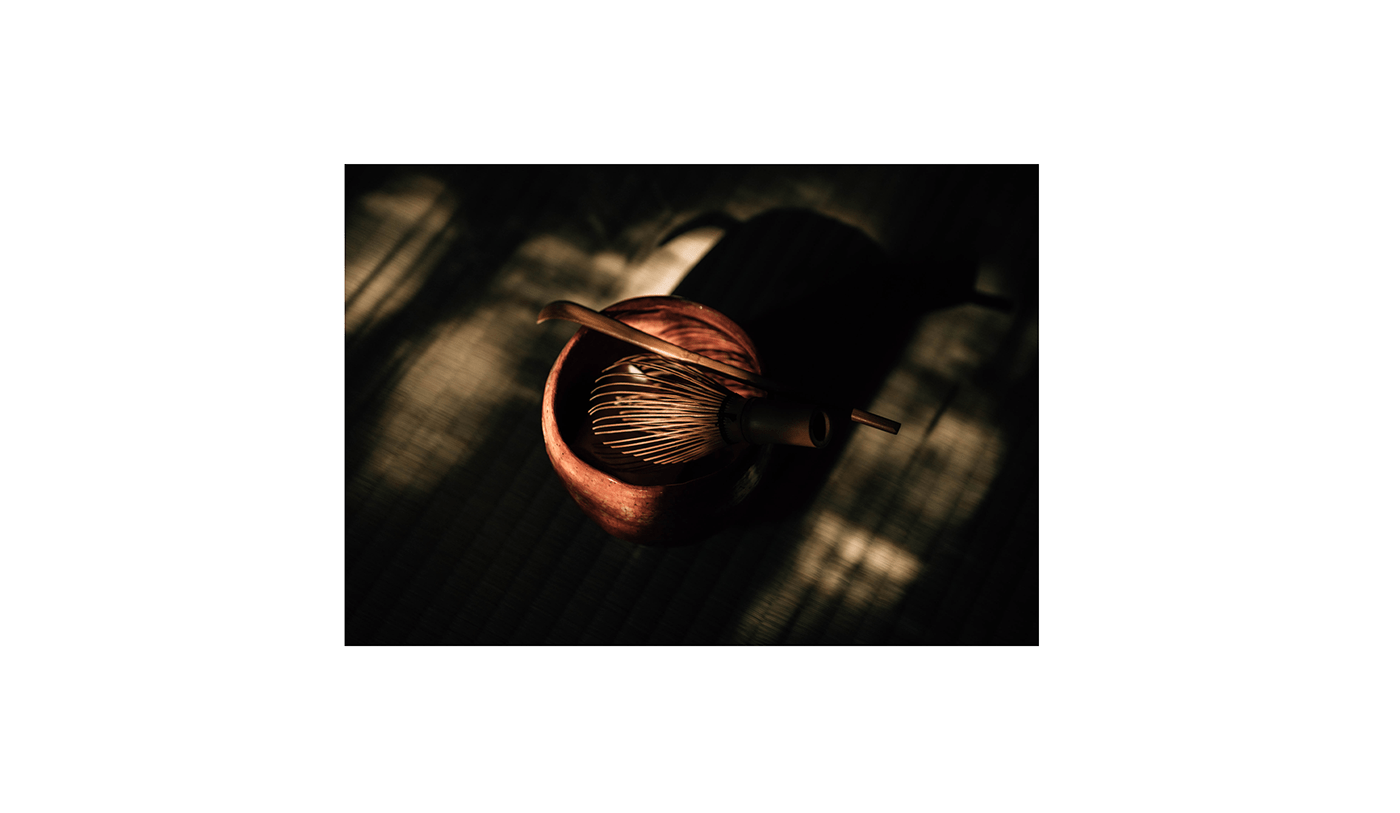MAKHNO STUDIO • ART OF HOME


KYOTO HOUSE
The art of tea is the art of life
Type: Private house
Year: 2023
Area: 135 m2
Design: Serhii Makhno
Photo: Naoki Miyashita
Year: 2023
Area: 135 m2
Design: Serhii Makhno
Photo: Naoki Miyashita
KYOTO HOUSE is a home for life and tea action in the heart of Kyoto. A place where ritual and everyday life, modernity and archaism, Japan and Ukraine merge into one.
This is a house where a pristine tradition is honored. What will later be called the Japanese style - eco-friendly materials, multifunctionality of the premises, minimalism in furniture and decoration, free space, restraint, adherence to the principles of wabi and sabi, meaning and symbolism in every decision.
This is a house with a soul.
__
__
KYOTO HOUSE — дім для життя і чайного дійства в самому серці Кіото. Місце, де зливаються в єдине ритуал та повсякденність, сучасність та архаїка, Японія та Україна.
Це дім, де вшановують первозданну традицію. Те, що згодом назвуть японським стилем — екологічність матеріалів, багатофункціональність приміщень, мінімалізм у меблях та оздобі, вільний простір, стриманість, прихильність принципам вабі і сабі, сенс та символізм у кожному рішенні.
Це дім з душею.



CHALLENGE
A century-old house where a family with kids lives has a unique history and atmosphere. The waves of time left traces on it, making it unique. Therefore, when reconstructing it, it was important not to destroy these feelings, but rather to refine and enhance them by adding a drop of Ukrainian color to the Japanese context.
That is why we have preserved many authentic elements in KYOTO HOUSE, such as original tatami mats or textured clay wall surfaces.
__
ВИКЛИК
Столітній будинок, у якому живе родина з малечею, має унікальну історію та атмосферу. Хвилі часу лишали на ньому сліди, роблячи неповторним. Тож реконструюючи його, важливим було не зруйнувати ці відчуття, а навпаки, витончити й підсилити їх, додавши до японського контексту краплю української барвистості.
Саме тому в KYOTO HOUSE ми зберегли безліч автентичних елементів, наприклад, оригінальні циновки татамі або фактурну глиняну поверхню стін.





And now the owner of the house in Kyoto expresses his respect to you and invites you to "sado", a tea performance in his humble home. This experience can be one of the most amazing in your life.
__
А зараз сам господар дому в Кіото висловлює вам свою повагу і запрошує до “садо”, чайного дійства в його смиренній оселі. Цей досвід може стати одним з найдивовижніших у вашому житті.

ROJI
The tea action begins at the entrance to the house. There is a small tea garden called "roji". It is decorated with Japanese ritual stones and Ukrainian DIDO art sculptures from the MAKHNO workshop. These good entities protect the house from sad thoughts and uninvited guests.
The meaning of the roji garden is that on your way to the master's house, you linger and admire for a minute, opening your heart to restrained beauty and your thoughts to poetic images.
And then the door of the house is slightly open. It means that you are expected.
__
РО-ДЗІ
Чайне дійство починається ще на підступах до будинку. Тут розгорнутий невеличкий чайний сад, що зветься “ро-дзі”. Його прикрашають японські ритуальні камені та українські артскульптури DIDO з майстерні MAKHNO. Ці добрі сутності захищають дім від сумних думок та непроханих гостей.
Смисл садка ро-дзі у тому, що прямуючи до господи чайного майстра, ви на хвилину затримуєтеся та милуєтесь, розкриваючи серце стриманій красі, а думки — поетичним образам.
Та ось і ледь відчинені двері дому. Значить, на вас чекають.






GENKAN
The entrance hall of a Japanese house is called "genkan," where you take off your shoes and leave them turned around until you leave. On the way to the spacious living room, you are greeted by collectible works of Japanese and Ukrainian art, as well as their owner. He respectfully invites you into the room.
__
ГЕНКАН
Передпокій японського будинку зветься “генкан”, тут ви знімаєте взуття та лишаєте розверненим до виходу. На шляху до просторої вітальні вас зустрічають колекційні витвори японського й українського мистецтва, а також їх господар. Він шанобливо запрошує вас до зали.



SHOIN-ZUKURI
You enter a spacious, bright room, the center of which is divided by a byobu, a light Japanese screen. The owner explains that the hall is multifunctional: on one side is his office with artwork and a niche for calligraphy tools; on the other is the living room where guests are received. And if they stay overnight, a couple of comfortable futons, traditional Japanese mattresses, are laid out here.
The owner talks about the interior of the "shoin-zukuri" or "study style" of the Japanese house, which originates from the design of the dwellings of Zen monks and samurai of the XV-XVI centuries. It can always be recognized by its characteristic "shoji" - sliding doors, as well as window and room partitions made of translucent sheets of rice paper in wooden frames. This is the first image that comes to mind when you think of Japanese interiors.
__
СЬОЇН-ДЗУКУРІ
Ви входите до просторої світлої зали, центр якої розділений “бьобу”, легкою японською ширмою. Господар пояснює, що зала багатофункціональна: з одного боку розташовується його кабінет з мистецькими виробами та нішею для каліграфічних інструментів; з іншого — вітальня, де приймають гостей. А якщо ті лишаються на ночівлю, тут розкладають пару зручних “футонів”, традиційних японських матраців.
Господар розповідає про інтер’єр “сьоїн-дзукурі” або “кабінетний стиль” японського будинку, що походить від оформлення житла дзенських монахів та самураїв XV-XVI століття. Його завжди можна впізнати за характерними “шьоджі” — це розсувні двері, а також віконні та кімнатні перегородки з напівпрозорих аркушів рисового паперу у дерев’яних рамах. Картинка, що першою спадає на думку при згадці японського



























CHASHITSU
After enjoying a leisurely conversation, the host invites you to the heart of KYOTO HOUSE - the tea room, or "chashitsu". This room used to serve as a bedroom, but now it is an authentic tearoom with a wabi-sabi spirit and all the proper attributes.
Decorated with new tatami and Japanese "vashi" paper, the tashitsu leads you to its center, where the "ro", a special fire for making tea, is located. It never goes out. Above the ro, you see a hanging teapot, and the owner is skillfully handling it.
The tea performance does not tolerate idle chatter. Therefore, in order to tune the spirit and soul, the host invites you to immerse yourself in meditation, contemplating the tokonoma.
__
ТЯШІЦУ
Насолодившись неспішною бесідою, господар запрошує вас у серце KYOTO HOUSE — до чайної кімнати, або “тяшіцу”. Це приміщення раніше слугувало спальнею, та тепер тут автентична ті-рум з духом вабі-сабі й усіма належними атрибутами.
Прикрашена новими татамі та японським папером “ваші”, тяшіцу веде вас до свого центру, де розташоване “ро”, спеціальне вогнище для приготування чаю. Воно ніколи не згасає. Над ро ви бачите підвісний чайник, господар майстерно вправляється з ним.
Чайне дійство не терпить пустих балачок. Тому, щоб налаштувати дух і душу, господар пропонує вам поринути у медитацію, споглядаючи токоному.





TOKONOMA
"Tokonoma" is the most honorable place in a Japanese home, a sign of an aristocratic house. It is a niche in the wall of a tashitsu where objects are placed to guide you on your tea journey.
Here is a "shepherd" - a special ikebana for a tea party that embodies the principles of wabi and sabi: restrained beauty and the transience of time. It is a minimalist bouquet of seasonal plants, often with only one flower. Chabana symbolizes the heart of the owner of the tashitsu.
The shepherdess is enveloped in a vase by the great Japanese master Shiro Tsujimura. Above it are scrolls with poetic sayings by calligraphy master Shuho Kondo. While your host is preparing tea, you plunge into the depths of paradoxical Eastern wisdom:
TRUE LIGHT SURPASSES SHINE AND DARKNESS, BUT CANNOT BE SEEN WITH THE EYES.
TRUE LIGHT IS BEYOND BRIGHT AND DARK
__
ТОКОНОМА
“Токонома” — найпочесніше місце японської оселі, ознака аристократичного дому. Це ніша в стіні тяшіцу, де розташовані предмети-провідники у чайній подорожі.
Ось “чабана” – спеціальна ікебана для чайного дійства, що втілює принципи вабі та сабі: стриману красу й мінливість часу. Це мінімалістичний букет з сезонних рослин, часто лише з однією квіткою. Чабана — символізує серце господаря тяшіцу.
Чабану огортає ваза великого японського майстра Широ Цудзимури. А над нею сувої з поетичним висловом, роботи майстра каліграфії Шухо Кондо. Доки господар готує чай, ви поринаєте у глибину парадоксальної східної мудрості:
ІСТИННЕ СВІТЛО ПЕРЕВЕРШУЄ СЯЙВО І ТЕМРЯВУ, ТА НЕ МОЖЕ БУТИ ПОБАЧЕНЕ ОЧИМА.
СПРАВЖНЄ СВІТЛО – ПОЗА ЯСКРАВИМ І ТЕМНИМ










SADO
Every movement of the tea master is precise and defined. There are no random steps, gestures, or even breaths. This is not a ceremony, but rather a spiritual experience, like a prayer liturgy. This practice is at once an active meditation, a sensual experience, and the highest form of communication. "The art of tea is the art of life," says the host, and you make a subtle bow of respect.
The Japanese tea ceremony is called "sado," literally "the way of tea." Originating in the 16th century, it is a highly ritualized meditative experience that reflects the principles of harmony, respect, purity, and tranquility. From that time to this day, this action has been the center of the Japanese spiritual life.
__
САДО
Кожен рух майстра чайного дійства точний та визначений. Тут немає випадкових кроків, жестів та навіть подихів. Це не церемонія, радше духовний досвід, наче молитвена літургія. Ця практика є водночас активною медитацією, чуттєвим переживанням та найвищою формою спілкування. “Мистецтво чаю — це мистецтво життя”, – говорить господар, і ви робите ледь помітний уклін шани.
Японське чайне дійство зветься “садо”, дослівно “шлях чаю”. Зародившись у 16 столітті, воно є високоритуалізованим медитативним досвідом, що відображає принципи гармонії, поваги, чистоти та спокою. Відтоді й до сьогодні це дійство є центром духовного життя японців.


CERAMICS
The master guides you through the path of tea, offering the life-giving liquid in a chawan, a traditional tea ceremony cup. The chawan perfectly embodies the principles and aesthetics of wabi-sabi - a handleless ceramic vessel made by hand, often without the use of a potter's wheel; simple and perfect in its imperfection. The older the vase, the more valuable it is. Because the history of an object is its soul.
At the end of the tea ceremony, the master shows you his collection of Japanese artistic ceramics of different schools and periods: products by Bidzen, Shigaraki, and others.
__
КЕРАМІКА
Майстер веде вас шляхом чаю, пропонуючи цілющу рідину у “чавані”, традиційній чашці для чайного дійства. Чаван ідеально втілює принципи й естетику вабі-сабі — це керамічна посудина без ручки, вироблена вручну, часто без використання гончарного круга; проста і досконала у своїй недосконалості. Чим старший чаван, тим він коштовніший. Бо історія предмета — це його душа.
Завершуючи чайне дійство, майстер демонструє вам свою колекцію японської художньої кераміки різних шкіл і періодів: вироби Бідзен, Сіґаракі та інші.


The owner tells us that the amazing Bidzen ware comes from the region of the same name in Okayama Prefecture, and it has a special native charm due to its reddish hues and slightly glossy surface texture. Bijen products have been created using authentic firing techniques without the use of glaze for more than five centuries, and it is one of the six oldest ceramic schools in Japan.
Shigaraki ware from Shiga Prefecture is also a prominent tradition. Ceramics here are characterized by a special technique of firing coarse clay in wood-fired kilns, which creates strong, golden-colored vessels with irregularities and a special aroma. This is the epitome of wabi-sabi. Since the 13th century, Shigaraki ware has been associated with tea parties due to its naturalness and aesthetics.
__
Господар розповідає: дивовижний посуд Бідзен походить з однойменного регіону префектури Окаяма, він вирізняється особливим свійським шармом, завдяки червонуватим відтінкам та ледь глянцевій фактурі поверхонь. Вироби Бідзен створюються за автентичними техніками випалу без використання глазурі вже понад п’ять століть, і це одна з шести найдревніших керамічних шкіл Японії.
Визначною традицією є й посуд Сіґаракі з префектури Сіґа. Кераміка тут характеризується особливою технікою випалювання грубої глини у дров'яних печах, так створюються міцні, золотистого кольору посудини з нерівностями та особливим ароматом. Це втілення вабі-сабі. Починаючи з 13 століття посуд Сіґаракі асоціюється з чайним дійством, завдяки своїй природності та естетичності.


ART
Along with Japanese ceramics, you can also see Ukrainian ceramics. Here's a whole family of DIDOs created by hand by hereditary potters in MAKHNO workshops. Perfect in every detail, they make a great company for the products of the most famous Japanese masters. After all, they continue the traditions of Ukrainian zoomorphic ceramics, which are more than three thousand years old and are now surprising the world.
__
__
АРТ
Поряд з японською керамікою ви бачите й українську. Ось ціла сім’я DIDO, що створені вручну спадковими гончарями в майстернях MAKHNO. Довершені в кожній деталі, вони складають чудову компанію виробам найвідоміших японських майстрів. Адже продовжують традиції української зооморфної кераміки, яким понад три тисячі років, і що сьогодні дивують світ.

Here you can find a ceramic lion by the famous Ukrainian potter Serhii Radko, plates and earthenware by MAKNO studio master Slavko Odarchenko, paintings by artist Oleksandr Babak, as well as traditional and modern Japanese graphics.
Looking at the diverse and restrainedly exquisite art collection of KYOTO HOUSE, you don't even notice that the house is enveloped in twilight. And while you are admiring the amazingly crafted DIDO, the owner of the house is laying out your futon in preparation for the evening sado.
__
__
Тут живе керамічний лев визначного українського гончаря Сергія Радька, тарілки та чавани майстра студії MAKNO Славка Одарченка, живопис художника Олександра Бабака, а також традиційна і сучасна японська графіка.
Роздивляючись різноманітну і стримано вишукану артколекцію KYOTO HOUSE, ви й не помітили, як дім огорнули сутінки. І допоки ви милуєтесь дивовижно-майстерно зробленим DIDO, господар будинку розкладає ваш футон, готуючись до вечірнього садо.






"IN THE ANCIENT CAPITAL OF JAPAN, IN AN OLD HOUSE,
WE CREATED A MODERN JAPANESE-UKRAINIAN DESIGN.
THIS IS A HOME FOR TEA AND LIFE"
- Serhii Makhno
__
“У ДРЕВНІЙ СТОЛИЦІ ЯПОНІЇ, У СТАРОВИННОМУ БУДИНКУ
МИ СТВОРИЛИ СУЧАСНИЙ ЯПОНСЬКО-УКРАЇНСЬКИЙ ДИЗАЙН.
ЦЕ ДІМ ДЛЯ ЧАЮ ТА ЖИТТЯ”
— Сергій Махно



ㅤ


